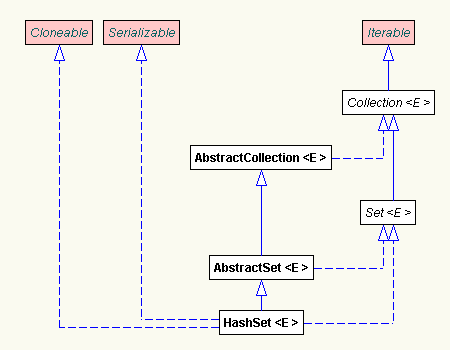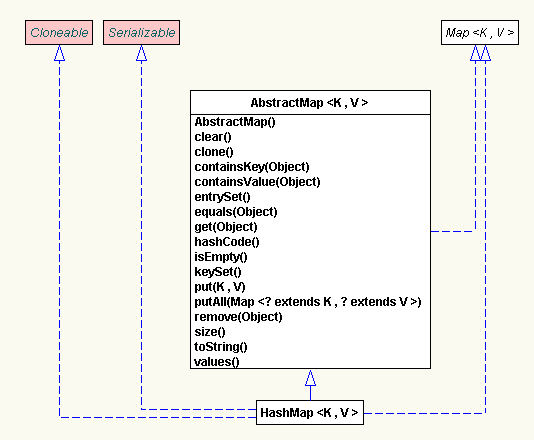Set
中的元素为什么不允许重复
版权所有,转载请声明出处
zhyiwww@163.com
为了弄清楚这个问题
,
我又看了一遍
Collection
部分
,
并且看了些其中的源码
,
觉得对其中的实现又明白了一点
,
现在说出来和大家共享
.
我们先看一下
Set
类的关系图:

现在我们就从
Set
说起。
Set
接口为我们提供了一个
add()
方法,以让我们添加元素。所以我们看一下在其实现类
HashSet
中是如何实现的呢?
我们看
HashSet
中的
add()
方法实现;
public boolean add(
E o
) {
return
map.put(o, PRESENT)==null;
}
你可能回问怎么回出来
map
了呢?
Map
又是一个什么变量呢?
我们来看
map
是在在哪定义的。原来,在
HashSet
中定义了这样的两个变量:
private transient HashMap<E,Object> map;
private static final Object PRESENT = new Object();
我们再看一下上面的
add()
方法。
map.put(o, PRESENT)==null
实际执行的是
map
的方法,并且我们添加的对象是
map
中的
key,value
是执行的同一个对象
PRESENT.
因为map中的key是不允许重复的,所以set中的元素不能重复。
下面我们再看一下,
map
又是如何保证其
key
不重复的呢?

现在我们看一下
map
中的
put()
方法的实现:
HashMap
实现了
map
,在
HashMap
中是这样实现的:
public V put(K key, V value) {
K k = maskNull(key);
int hash = hash(k);
int i = indexFor(hash, table.length);
for (Entry<K,V> e = table[i]; e != null; e = e.next) {
if (e.hash == hash && eq(k, e.key)) {
V oldValue = e.value;
e.value = value;
e.recordAccess(this);
return oldValue;
}
}
modCount++;
addEntry(hash, k, value, i);
return null;
}
我们我们按照方法的执行一步一步的来看一下,其实现的过程。
K k = maskNull(key);
这一步是要判断当前的要添加的对象的
key
是否为空,如果为空的话,那么就生成一个新的对象作为其
key
。实现如下:
static final Object NULL_KEY = new Object();
* Returns internal representation for key. Use NULL_KEY if key is null.
static <T> T maskNull(T key) {
return key == null ? (T)NULL_KEY : key;
}
之后
int hash = hash(k);
我们看一下
hash()
方法的实现:
static int hash(Object x) {
int h = x.hashCode();
h += ~(h << 9);
h ^= (h >>> 14);
h += (h << 4);
h ^= (h >>> 10);
return h;
}
这一步其实是要得到当前要添加对象的
hashcode,
方法中,首先通过
int h = x.hashCode()
取得了当前的要添加对象的
hashcode,
然后
h += ~(h << 9);
h ^= (h >>> 14);
h += (h << 4);
h ^= (h >>> 10);
生成一个新的
hashcode.
接着执行的是
(从此处开始,我理解的比较肤浅,请看到此出的朋友多多指点)
int i = indexFor(hash, table.length);
这个方法是要
Returns index for hash code h.
static int indexFor(int h, int length) {
return h & (length-1);
}
下面就要根据
hashmap
中的元素逐个的比较,看是否相同,如果不同就回添加一个新的元素。是通过循环判断来实现的。
for (Entry<K,V> e = table[i]; e != null; e = e.next) {
if (e.hash == hash && eq(k, e.key)) {
V oldValue = e.value;
e.value = value;
e.recordAccess(this);
这句我的理解是:在内存中的可以访问元素又多了一个。也就是说,添加之后,可以通过hashmap来访问此元素了。
return oldValue;
}
}
通过循环判断是否有完全相同的对象,包括
hashcode
和
value
值。如果已经存在就返回其值,如果不存在就执行一下操作。
modCount++;
addEntry(hash, k, value, i);
return null;
对象不存在,首先修改
hashmap
的修改次数,即
modCount
加
1.
然后将对象添加到数组中。
void addEntry(int hash, K key, V value, int bucketIndex) {
Entry<K,V> e = table[bucketIndex];
table[bucketIndex] = new Entry<K,V>(hash, key, value, e);
if (size++ >= threshold)
resize(2 * table.length);
}
仍然是数组,我们来看一下
,
在
hashmap
中用来存放对象的数组的定义:
transient Entry[] table;
至此,我想大家也许应该明白了,为什么在
set
中是不允许存放重复值的。
通过才的分析,我们可以看到,
map
的一些特征:
1.
在
map
中也是不能存放完全相同的元素的
2.
如果你存入的对象的
key
值已经存在的话,那么新的
value
将会取代老的
value
值,但是并不会添加新的元素进去。
我们可以通过一个测试程序来证明这一点:
public void mapTest() {
Map m = new HashMap();
/**
* we can put the int 1 and the value 1 into the map
* but we cannot get the 1 as int from the map
* why ?
* we only get the 1 as integer from the map,
* so we only get the object from the map,if we put the value into
* the map,we will get one instance of the wrapper of that
*/
m.put(1, 1);
//int i = m.get(1);
Integer i = (Integer) m.get(1);
System.out.println(i);
m.put(1, 1);
m.put(1, 1);
System.out.println("map : " + m);
System.out.println("map size : " + m.size());
m.put(1, 2);
System.out.println("map : " + m);
System.out.println("map size : " + m.size());
}
运行的结果是:
map : {1=1}
map size : 1
map : {1=2}
map size : 1
希望此文能大家有所帮助。
|----------------------------------------------------------------------------------------|
版权声明 版权所有 @zhyiwww
引用请注明来源 http://www.blogjava.net/zhyiwww
|----------------------------------------------------------------------------------------|
posted on 2006-03-30 09:41
zhyiwww 阅读(3678)
评论(0) 编辑 收藏 所属分类:
java basic